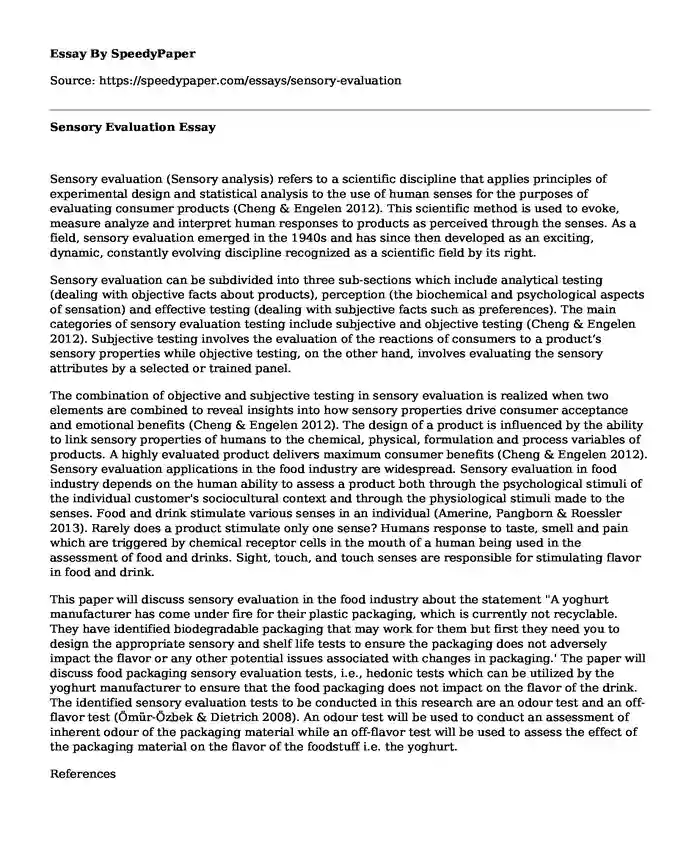Sensory evaluation (Sensory analysis) refers to a scientific discipline that applies principles of experimental design and statistical analysis to the use of human senses for the purposes of evaluating consumer products (Cheng & Engelen 2012). This scientific method is used to evoke, measure analyze and interpret human responses to products as perceived through the senses. As a field, sensory evaluation emerged in the 1940s and has since then developed as an exciting, dynamic, constantly evolving discipline recognized as a scientific field by its right.
Sensory evaluation can be subdivided into three sub-sections which include analytical testing (dealing with objective facts about products), perception (the biochemical and psychological aspects of sensation) and effective testing (dealing with subjective facts such as preferences). The main categories of sensory evaluation testing include subjective and objective testing (Cheng & Engelen 2012). Subjective testing involves the evaluation of the reactions of consumers to a product's sensory properties while objective testing, on the other hand, involves evaluating the sensory attributes by a selected or trained panel.
The combination of objective and subjective testing in sensory evaluation is realized when two elements are combined to reveal insights into how sensory properties drive consumer acceptance and emotional benefits (Cheng & Engelen 2012). The design of a product is influenced by the ability to link sensory properties of humans to the chemical, physical, formulation and process variables of products. A highly evaluated product delivers maximum consumer benefits (Cheng & Engelen 2012). Sensory evaluation applications in the food industry are widespread. Sensory evaluation in food industry depends on the human ability to assess a product both through the psychological stimuli of the individual customer's sociocultural context and through the physiological stimuli made to the senses. Food and drink stimulate various senses in an individual (Amerine, Pangborn & Roessler 2013). Rarely does a product stimulate only one sense? Humans response to taste, smell and pain which are triggered by chemical receptor cells in the mouth of a human being used in the assessment of food and drinks. Sight, touch, and touch senses are responsible for stimulating flavor in food and drink.
This paper will discuss sensory evaluation in the food industry about the statement "A yoghurt manufacturer has come under fire for their plastic packaging, which is currently not recyclable. They have identified biodegradable packaging that may work for them but first they need you to design the appropriate sensory and shelf life tests to ensure the packaging does not adversely impact the flavor or any other potential issues associated with changes in packaging.' The paper will discuss food packaging sensory evaluation tests, i.e., hedonic tests which can be utilized by the yoghurt manufacturer to ensure that the food packaging does not impact on the flavor of the drink. The identified sensory evaluation tests to be conducted in this research are an odour test and an off-flavor test (Omur-Ozbek & Dietrich 2008). An odour test will be used to conduct an assessment of inherent odour of the packaging material while an off-flavor test will be used to assess the effect of the packaging material on the flavor of the foodstuff i.e. the yoghurt.
References
Altner, H., Dudel, J., Grusser, O.J., Grusser-Cornehls, U., Klinke, R. & Zimmermann, M., 2012. Fundamentals of sensory physiology. Springer Science & Business Media.
Amerine, M. A., Pangborn, R. M., & Roessler, E. B. (2013). Principles of sensory evaluation of food. Elsevier.
Chen, J. & Engelen, L., 2012. Food oral processing: fundamentals of eating and sensory perception. John Wiley & Sons. Goody, J., 2002. The anthropology of the senses and sensations. La Ricerca folklorica, pp.17-28.
Omur-Ozbek, P. and Dietrich, A.M., 2008. Developing hexanal as an odor reference standard for sensory analysis of drinking water. Water research, 42(10-11), pp.2598-2604.
Cite this page
Sensory Evaluation. (2022, Nov 23). Retrieved from https://speedypaper.net/essays/sensory-evaluation
Request Removal
If you are the original author of this essay and no longer wish to have it published on the SpeedyPaper website, please click below to request its removal:
- Essay Example on Advantages of Networking
- Sirius XM Case Analysis Sample
- Free Essay Disclosing General Causes of Recidivism
- Free Essay on Self-Evaluation at All Career Stages
- Philosophy Essay Example: Problem of Evil
- Application for Admission to the Masters in Arts in Counseling Psychology Program
- Paper Example. Introduction to Early Childhood Education
Popular categories





